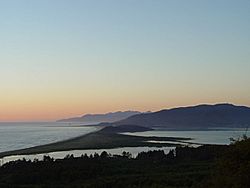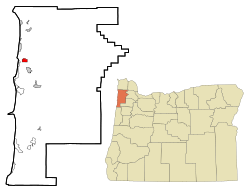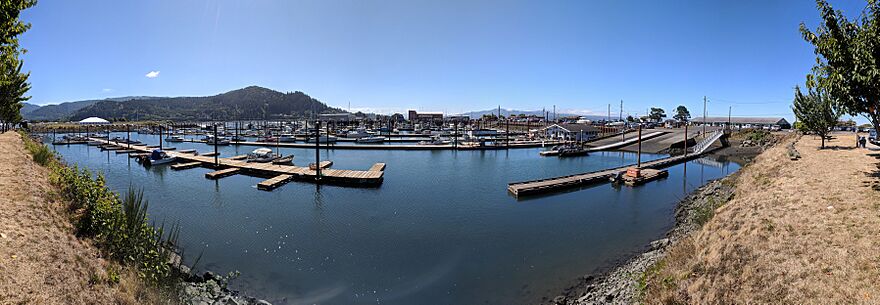Garibaldi, Oregon facts for kids
Quick facts for kids
Garibaldi, Oregon
|
|
|---|---|

Garibaldi and Tillamook Bay
|
|
| Motto(s):
"Oregon's Authentic Fishing Village"
|
|

Location in Oregon
|
|
| Country | United States |
| State | Oregon |
| County | Tillamook |
| Incorporated | 1946 |
| Area | |
| • Total | 1.37 sq mi (3.54 km2) |
| • Land | 0.99 sq mi (2.55 km2) |
| • Water | 0.38 sq mi (0.99 km2) |
| Elevation | 36 ft (11 m) |
| Population
(2020)
|
|
| • Total | 830 |
| • Density | 841.78/sq mi (324.87/km2) |
| Time zone | UTC-8 (Pacific) |
| • Summer (DST) | UTC-7 (Pacific) |
| ZIP code |
97118
|
| Area code(s) | 503 |
| FIPS code | 41-28000 |
| GNIS feature ID | 2410571 |
| Website | www.ci.garibaldi.or.us |
Garibaldi (pronounced GARR-ib-AWL-dee) is a small city in Tillamook County, Oregon. It is located on the coast of the U.S. state of Oregon. In 2020, the city had a population of 830 people.
History of Garibaldi
Early Inhabitants: The Tillamook People
The native Tillamook people have lived along the Oregon coast for about 12,000 years. Their land stretched from Tillamook Head in the north to Cape Foulweather in the south. They also lived inland to the Oregon Coast Range.
The Tillamook people lived in strong cedar-plank homes. They used torches or burning fish oil to light their homes at night. Their diet included salmon, mussels, berries, and animals like deer and elk.
European Contact and Changes
In 1788, Captain Robert Gray sailed his ship, the Lady Washington, into Tillamook Bay. His crew had a conflict with the Tillamook people. Later, in 1806, the Lewis and Clark expedition reported that about 2,400 Tillamook people lived on Oregon's coast.
As more white settlers arrived, the native population faced new diseases like smallpox. By 1930, only 22 native people remained in all of Tillamook County.
How Garibaldi Got Its Name
Daniel Bayley was the first white person to own land in this part of Tillamook Bay. He settled here after the American Civil War. Bayley built a hotel and a general store. In 1869, he officially received the land title from President Ulysses S. Grant.
In 1870, President Grant made Bayley the first postmaster for the area. Bayley was given the job of naming the post office. At that time, Giuseppe Garibaldi was famous for helping to unify Italy. He was also known for his efforts to bring democracy around the world. Bayley admired him greatly and decided to name the post office "Garibaldi" after his hero.
The Hobsonville Indian Community
Starting in the 1870s, many native people in the region were moved to the Hobsonville Indian Community nearby. By the 1930s, this community mostly had elderly women and children. It was sometimes called "Squawtown."
Tourists would visit, and people who bought old items would come. Sadly, the local Ku Klux Klan sometimes bothered the residents. The community was empty by World War II, and some residents moved to Garibaldi.
Schools in Garibaldi
Garibaldi's first school, Hobson School, was built in 1896. In 1907, it moved closer to its current spot. In 1926, a new high school opened in Garibaldi. This meant students no longer had to go to high school in Bay City.
In 1954, high schools in northern Tillamook County joined together to form Neah-Kah-Nie High School. This new school was north of Rockaway Beach. Garibaldi High School then became a grade school for younger students.
Industry and Growth
The Whitney mill opened in Garibaldi in 1921. The tall smokestack you see today was built by the Hammond Company in 1927–28.
Garibaldi officially became a city in 1946. In the 1950s, the city's population grew to over 1500 people. This was because two large mills, The Oceanside Lumber Company and Oregon-Washington Plywood Corporation, were built. The Oregon-Washington Mill closed in the late 1970s.
A Weyerhaeuser hardwood mill at the Port of Garibaldi was bought by a New York company in 2011. It has been running as Northwest Hardwoods, Inc. since then.
The Captain Robert Gray Statue
In 2020, a writer named Helen Hill suggested removing the statue of Captain Robert Gray in Garibaldi. This was due to concerns about how he treated native people. The statue is outside the Garibaldi Maritime Museum. It shows Gray standing on a sacred box with Haida designs. As of 2020, the museum's board was thinking about adding more information next to the statue.
Geography of Garibaldi
Garibaldi covers a total area of about 1.37 square miles (3.54 square kilometers). Most of this area, about 0.99 square miles (2.55 square kilometers), is land. The remaining 0.38 square miles (0.99 square kilometers) is water.
Population and People
| Historical population | |||
|---|---|---|---|
| Census | Pop. | %± | |
| 1930 | 213 | — | |
| 1950 | 1,249 | — | |
| 1960 | 1,163 | −6.9% | |
| 1970 | 1,083 | −6.9% | |
| 1980 | 999 | −7.8% | |
| 1990 | 877 | −12.2% | |
| 2000 | 899 | 2.5% | |
| 2010 | 779 | −13.3% | |
| 2020 | 830 | 6.5% | |
| 1930 population U.S. Decennial Census |
|||
Garibaldi's Population in 2010
Based on the census from 2010, there were 779 people living in Garibaldi. These people made up 384 households and 222 families. The city had about 787 people per square mile (304 people per square kilometer).
Most of the people in Garibaldi were White (94.7%). There were also small numbers of African American (0.1%), Native American (0.8%), and Asian (0.9%) residents. About 3.5% of the population was Hispanic or Latino.
Households and Families
Out of 384 households, 15.4% had children under 18 living with them. About 47.4% were married couples living together. Some households (8.1%) had a female head with no husband, and 2.3% had a male head with no wife. About 42.2% were non-family households.
Many households (33.9%) had only one person living in them. About 13.3% had someone aged 65 or older living alone. The average household had 1.99 people, and the average family had 2.45 people.
Age and Gender in Garibaldi
The average age in Garibaldi in 2010 was 55.1 years old.
- 12.5% of residents were under 18 years old.
- 5.1% were between 18 and 24 years old.
- 13% were between 25 and 44 years old.
- 41.4% were between 45 and 64 years old.
- 28.1% were 65 years or older.
The population was almost evenly split between genders: 50.6% male and 49.4% female.
See also
 In Spanish: Garibaldi (Oregón) para niños
In Spanish: Garibaldi (Oregón) para niños


